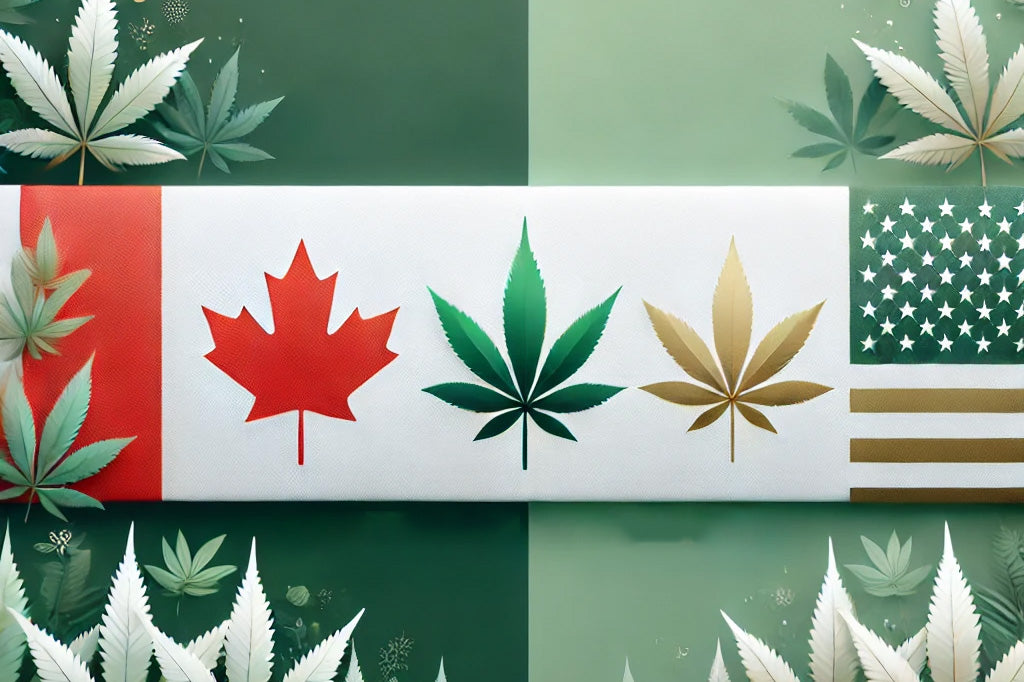
Cannabis Industry Showdown: Canada vs. U.S. - A Comparative Look at Two Booming Markets
Share
Exploring the differences in legalization, market growth, and regulatory frameworks between Canada and the United States in the ever-evolving cannabis industry.
Introduction
The cannabis industry has experienced explosive growth in both Canada and the U.S., but the markets operate under vastly different conditions. Canada became the first G7 nation to fully legalize cannabis in 2018, while the U.S. is still navigating a state-by-state approach to legalization. In this blog, we’ll compare the two markets, discussing regulatory frameworks, market trends, and the future outlook for each nation.
Legalization and Regulatory Framework
Canada’s Full Legalization: Canada took a monumental step in October 2018 by fully legalizing cannabis for both medical and recreational use under the Cannabis Act. This move created a unified, federal framework that allows companies to operate without the fear of conflicting state and federal laws. Regulations are primarily focused on product safety, age restrictions, and quality control, with strict guidelines on packaging and advertising.
U.S. Patchwork Legalization: In contrast, the U.S. cannabis industry remains fragmented. While 24 states, three territories and the District of Columbia have legalized cannabis for recreational use as of Nov. 24 2023 and 38 states, three territories and the District of Columbia have legalized cannabis for medical use as of Apr. 24 2023, it is still federally illegal under the Controlled Substances Act. This causes complications for businesses, as federal banking services, interstate commerce, and supply chain logistics face regulatory hurdles. State laws vary dramatically, creating a less cohesive market compared to Canada’s.
Market Size and Growth Potential
Canada’s Mature Market: Since full legalization, Canada has built a robust cannabis industry, but the growth has plateaued somewhat due to market saturation. By 2023, Sales of recreational cannabis by provincial cannabis authorities and other retail outlets increased 15.8% to $4.7 billion in the 2022/2023, with potential for more incremental growth as new products like edibles and beverages gain popularity.
U.S. Market’s Untapped Potential: The U.S. cannabis market, despite legal constraints, dwarfs Canada’s due to its larger population and piecemeal state legalization. $30 billion in 2022 and are projected to surpass $35 billion in 2023, with projections suggesting it could exceed $71 billion by 2030 if federal legalization occurs. This positions the U.S. market as the largest in the world, offering significant opportunities for investors and businesses once federal barriers are removed.
Consumer Preferences and Trends
Canada: Shifting Towards Premium Products: As the Canadian market matures, consumers are increasingly gravitating toward premium, high-quality products. Organic, sustainable, and craft cannabis brands are gaining popularity, with edibles and infused beverages also seeing a rise in demand.
U.S.: Diverse State Markets with Varied Preferences: Consumer trends in the U.S. are more diverse, given the country’s patchwork of regulations. States like California and Colorado have highly developed markets where consumers seek innovative products, including vapes, edibles, and concentrates. Newer markets like New York are still focused on educating consumers and introducing basic products.
Challenges and Future Outlook
Canada’s Regulatory Hurdles: Despite the initial buzz surrounding legalization, Canadian cannabis companies have faced challenges such as regulatory bottlenecks, oversupply, and high taxes. Moving forward, companies will need to innovate and adapt to consumer demands to maintain growth.
U.S. Legalization Prospects: In the U.S., the primary challenge remains federal legalization. Until the federal government lifts the cannabis ban, businesses must navigate complex state laws, limited access to financial services, and the inability to transport products across state lines. However, once federal legalization occurs, the U.S. cannabis market is poised for exponential growth, attracting both domestic and international investments.
Conclusion
Both Canada and the U.S. have vibrant, growing cannabis industries, each with its unique opportunities and challenges. While Canada enjoys a unified regulatory framework, the U.S. market offers unmatched growth potential despite its legal fragmentation. As consumer preferences shift and regulations evolve, both countries are likely to play pivotal roles in shaping the future of the global cannabis market.
